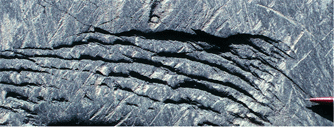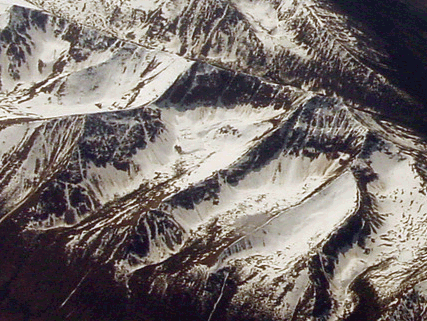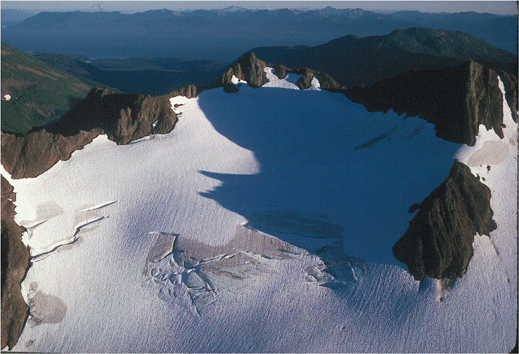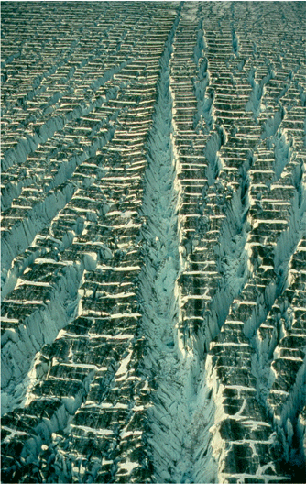Calving
The process by which pieces of ice break away from the terminus
of a glacier that ends in a body of water or from the edge
of a floating ice shelf that ends in the ocean. Once they
enter the water, the pieces are called icebergs.

Southwest-looking photograph showing a large calving
wave and many recently-calved pieces of ice moving
away from the terminus of Johns Hopkins Glacier,
following a major calving event, St Elias Mountains,
Glacier Bay National Park, Alaska. |
|
|
Chatter Marks
A series of small, closely spaced, crescentic grooves
or scars formed in bedrock by rocks frozen in basal
ice as they move along and chip the glacier's bed. The
horns of the crescent generally point down glacier.

Close-up photograph of the surface of a recently
deglacierized bedrock outcrop adjacent to Yale
Glacier, Yale Arm, College Fiord, Chugach Mountains,
Chugach National Forest, Prince William Sound,
Alaska, showing a series of more than one-half-dozen
nested arcuate chatter marks and a number of multi-directional,
linear striations. Note the tip of the pen for
scale. |
|
|

Southwest-looking oblique aerial photograph showing
a number of snow-covered cirques, cut into the summit
of a Coast Mountains ridge along the Alaska - Canada
border, east of Glacier Bay National Park, Alaska.
Note the uniform snowline. |
Cirque
A bowl-shaped, amphitheater-like depression eroded into the
head or the side of a glacier valley. Typically, a cirque
has a lip at its lower end. The term is French and is derived
from the Latin word circus.
|

North-looking oblique aerial photograph showing
an ice and snow-filed cirque in the accumulation
area of the Fairweather Range, east of Mount Fairweather,
Glacier Bay National Park, Alaska. |
|

Northeast-looking oblique aerial photograph showing
several ice and snow-filed cirques on the west flank
of Mount Fairweather, Fairweather Range, Glacier
Bay National Park, Alaska. |
|
|
Crescentic Gouge
Any curved mark or fracture produced by plucking or chipping
of the glacier's bed. Larger than chatter marks,typically
the horns of these gouges point up glacier. Also called
Lunate Fracture or Crescentic Mark.

Close-up photograph of the surface of a recently
deglacierized bedrock outcrop adjacent to Yale
Glacier, in Yale Arm, College Fiord, Chugach National
Forest, Prince William Sound, Alaska. It shows
an irregularly-shaped, deeply incised crescentic
gouge, several nested arcuate chatter marks and
a number of multi-directional, linear striations.
Note the tip of the pen for scale. |
|
|

East-looking photograph showing two recently opened
crevasses in July 1976 on the surface of Taku Glacier,
Juneau Icefield, Tongass National Forest, Coast
Mountains, Alaska. The longer of the two crevasses
extends for nearly a kilometer. |
Crevasse
A crack or series of cracks that open in the surface of a
moving glacier in response to differential stresses caused
by glacier flow. They range in shape from linear to arcuate,
in length from feet to miles. Their orientation may be in
any direction with respect to the glacier flow. The deepest
crevasses may exceed 100 feet.

northeast-looking oblique aerial photograph showing
several parallel and sub-parallel open crevasses
on the surface of the piedmont lobe of Bering Glacier,
Alaska in July 1994. Perpendicular to the open crevasses
are a number of snow-filed crevasses. The snow-filled
crevasses formed a year earlier, when this part
of the glacier flowed through an area subject to
a different stress field. The long crevasse in the
center of the photograph extends for nearly 2 miles.
Bering Glacier flows through Wrangell-Saint Elias
National Park. |
|
|
|

